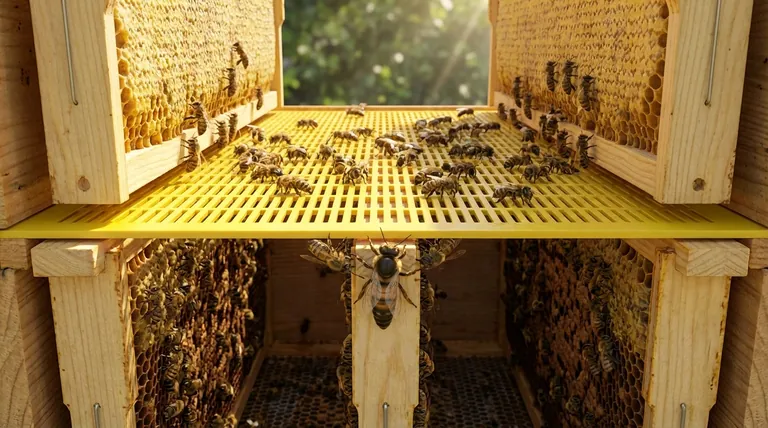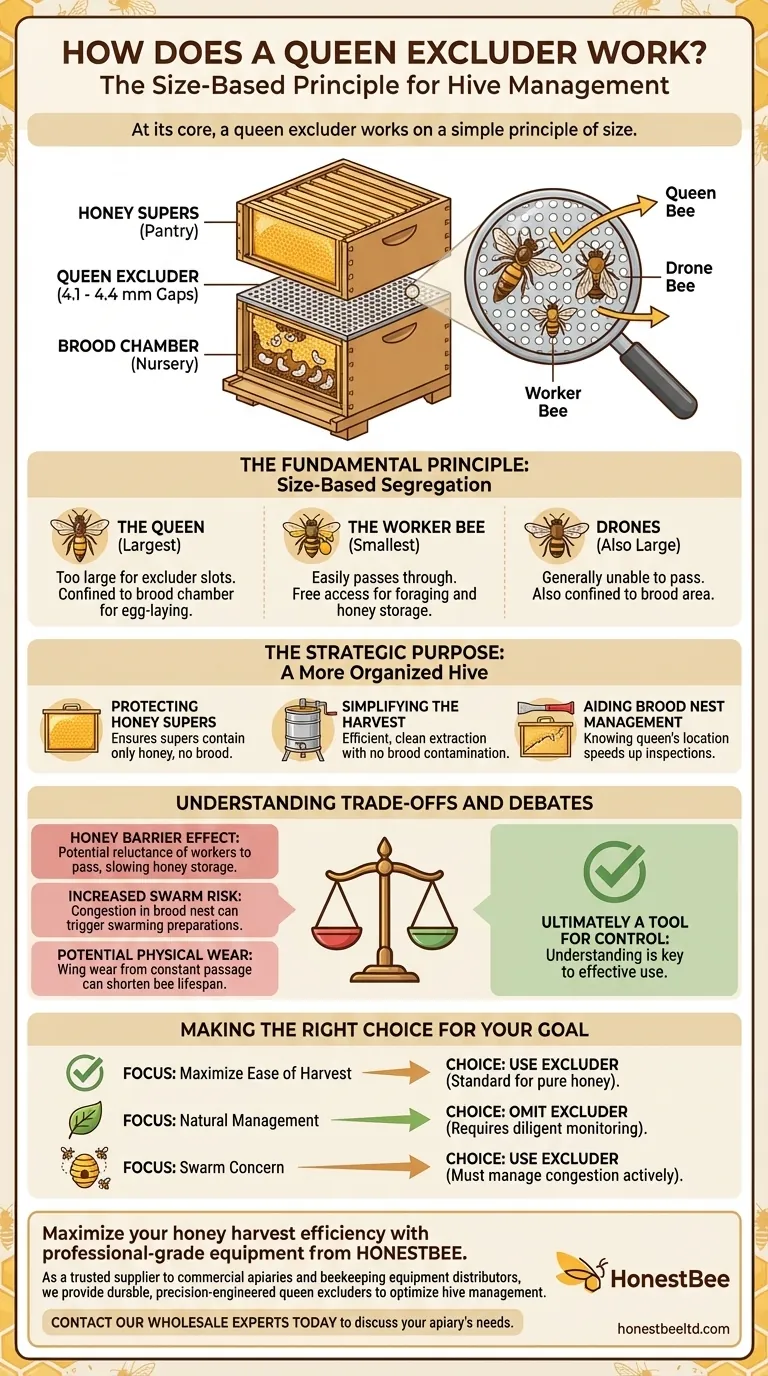At its core, a queen excluder works on a simple principle of size. It is a perforated grid, typically made of metal or plastic, that is placed between the hive's brood chamber and the honey storage boxes (supers). The gaps in this grid are precisely engineered—usually between 4.1 and 4.4 millimeters—to be large enough for worker bees to pass through but too small for the larger thorax of a queen bee. This effectively confines the queen to the lower part of the hive.
The queen excluder isn't just a physical barrier; it's a strategic management tool. It imposes a clear separation between the colony's nursery (the brood chamber) and its pantry (the honey supers), which dramatically simplifies the process of harvesting honey.

The Fundamental Principle: Size-Based Segregation
A bee colony has three distinct types of bees, and the excluder leverages their physical differences to organize the hive.
The Queen's Anatomy
The queen bee is the largest bee in the colony. Her primary role is to lay eggs, and her larger thorax and abdomen prevent her from squeezing through the narrow slots of the excluder.
The Worker Bee's Advantage
Worker bees are the smallest adults in the hive. They are responsible for foraging, building comb, and storing honey, so they must have free access to all parts of the hive. The excluder is designed specifically to allow them unimpeded passage.
What About Drones?
Drones, the male bees, are also larger than worker bees. Like the queen, they are generally unable to pass through the excluder. This means both the queen and the drones are confined to the brood chamber area below the excluder.
The Strategic Purpose: A More Organized Hive
Beekeepers use excluders not just to block the queen, but to enforce a specific structure within the hive that serves several practical purposes.
Protecting the Honey Supers
The primary goal is to ensure the honey supers contain only honey. When a queen lays eggs in a honey frame, the resulting area of brood makes harvesting messy and difficult.
Simplifying the Harvest
By keeping the honey frames free of eggs, larvae, and pupae, the beekeeper can extract honey far more efficiently. There is no risk of damaging brood or contaminating the honey with it.
Aiding Brood Nest Management
Using an excluder allows a beekeeper to know with certainty where the queen is located (below the excluder). This can speed up hive inspections when the goal is simply to check the honey supers.
Understanding the Trade-offs and Debates
While useful, the queen excluder is a topic of debate among beekeepers. Its use comes with potential downsides that must be managed.
The "Honey Barrier" Effect
Some beekeepers believe that workers are reluctant to pass through the excluder, creating a psychological barrier that can slow the rate at which they store honey in the supers above. This can potentially lead to a lower overall honey yield.
Increased Swarm Risk
By confining the queen to a limited area, the brood nest can become congested with bees, pollen, and brood more quickly. This congestion is a primary trigger for the colony to begin swarm preparations.
Potential for Physical Wear
Bees constantly moving through the narrow slots can experience wear and tear on their wings, particularly with metal excluders. This can shorten their lifespan and slightly reduce the foraging workforce's efficiency.
Making the Right Choice for Your Goal
Deciding whether to use a queen excluder depends entirely on your beekeeping philosophy and objectives.
- If your primary focus is maximizing ease of harvest: Using an excluder is the standard commercial practice to guarantee pure, brood-free honey frames.
- If your primary focus is a more "natural" hive management style: You might omit the excluder and allow the queen to roam, but this requires diligent monitoring to ensure she leaves enough room for honey storage.
- If you are concerned about swarming: Using an excluder means you must be extra vigilant about providing adequate space and managing congestion in the brood chamber.
Ultimately, the queen excluder is a tool that gives the beekeeper control, and understanding its function and consequences is the key to using it effectively.
Summary Table:
| Function | Key Detail | Benefit for Beekeepers |
|---|---|---|
| Physical Barrier | Slots are 4.1-4.4mm wide. | Allows worker bees to pass but blocks the larger queen. |
| Hive Organization | Separates brood chamber from honey supers. | Ensures honey frames are free of eggs and brood. |
| Harvest Simplification | Confines queen to the lower hive body. | Enables efficient, clean honey extraction. |
Maximize your honey harvest efficiency with professional-grade equipment from HONESTBEE.
As a trusted supplier to commercial apiaries and beekeeping equipment distributors, we provide the durable, precision-engineered queen excluders and other essential supplies you need to optimize hive management and protect your honey yield.
Contact our wholesale experts today to discuss your apiary's needs and discover how our solutions can support your operation's success.
Visual Guide

Related Products
- Professional Plastic Queen Excluder for Modern Beekeeping
- Premium Wood Framed Metal Wire Queen Bee Excluder
- Wooden Queen Bee Excluder for Beekeeping
- Plastic Queen Bee Excluder for Bee Hive Wholesale
- High Performance Plastic Queen Excluder for Beekeeping and Apiary Management
People Also Ask
- What is the primary function of a queen excluder in beekeeping? Control Hive Layout for Efficient Honey Harvesting
- Why are queen excluders recommended for Flow Hives? Prevent Brood Damage for a Clean Harvest
- What are the pros of using a queen excluder? Boost Hive Control & Honey Quality
- What is the role of a queen excluder when adding a super? Ensure Brood-Free Honey Harvests
- What are the main advantages of using a queen excluder in beekeeping? Simplify Hive Management & Harvest



















